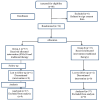Efficacy of Mulligan thoracic sustained natural apophyseal glides on sub-acromial pain in patients with sub-acromial impingement syndrome: a single-blinded randomized controlled trial
- PMID: 38618993
- PMCID: PMC11578423
- DOI: 10.1080/10669817.2024.2341453
Efficacy of Mulligan thoracic sustained natural apophyseal glides on sub-acromial pain in patients with sub-acromial impingement syndrome: a single-blinded randomized controlled trial
Abstract
Purpose: To investigate the effects of Mulligan thoracic sustained natural apophyseal glides (SNAGS) techniques and traditional exercises on pain, shoulder function, size of sub-acromial space, and shoulder joint range in patients with sub-acromial impingement syndrome.
Methods: Seventy-four patients with sub-acromial impingement syndrome (25 to 40 years) joined this research and were allocated randomly into two equal groups; experimental group A (Mulligan SNAGS and exercise) and control group B (exercise only). All patients were assessed by visual analogue scale (VAS) for pain intensity, Shoulder Pain and Disability Index (SPADI) for shoulder function, plain x-ray for the size of sub-acromial space, and goniometer for shoulder range of motion (ROM). The measurements were performed at two intervals (baseline and after four weeks of intervention).
Results: After 4 weeks of intervention, there were statistically significant differences between groups, in favor of Mulligan SNAGS, on sub acromial space size, pain intensity, shoulder function, and shoulder joint range of motion (p < 0.05). In within-group analysis, there were also statistically significant differences between pre- and post-treatment in all measured variables (p < 0.05).
Conclusion: Mulligan thoracic spine (SNAGS) mobilization into extension and traditional exercises improve sub acromial space size, pain intensity, shoulder function, and shoulder joint range of motion in patients with sub acromial impingement syndrome. It is recommended to mobilize the thoracic spine by mulligan SNAGS in the treatment of sub-acromial impingement syndrome.
Keywords: Sub-acromial pain; impingement syndrome; size of sub-acromial space; thoracic spine SNAGS.
Conflict of interest statement
No potential conflict of interest was reported by the author(s).
Figures
References
-
- Creech JA, Silver S. Shoulder impingement syndrome. StatPearls [Internet]. Treasure Island (FL): StatPearls Publishing; 2024. [updated 2023 Apr 17]. Available from: https://www.ncbi.nlm.nih.gov/books/NBK554518/ - PubMed
Publication types
MeSH terms
LinkOut - more resources
Full Text Sources



